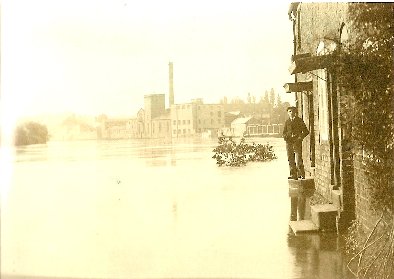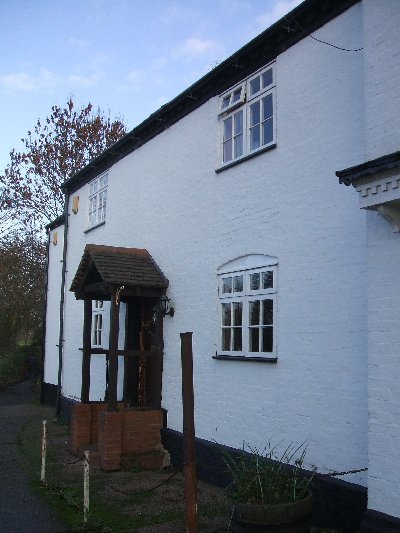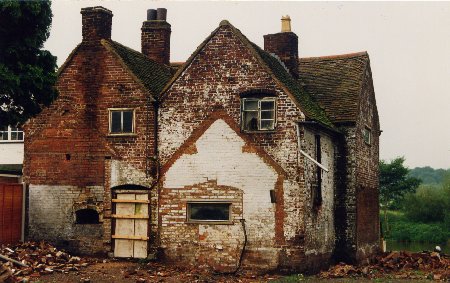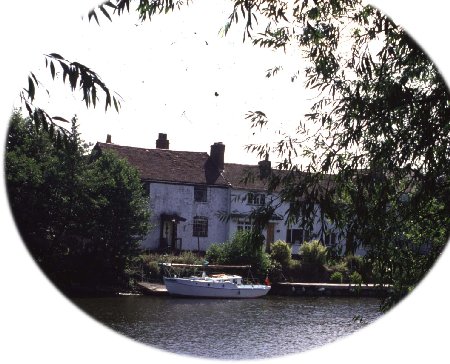

Staking/Stacking/Cloth House, Hartlebury
Alan D Dyer in his book 'The City of Worcester in the Sixteenth century' says that the clothiers of Worcester used a boat called the cloth barge to take the cloths up the River Severn to be fulled at the fulling mill in Hartlebury. The use of the boat on Sundays was a cause of concern both to the Corporation of Worcester and particularly the ecclesiastical authorities. At the Chamber Meeting of the Corporation of the City of Worcester of 18 March 1635/6 it was agreed that the corporation would buy the Staking House; at a meeting of 17 June 1636 it was agreed that the cloth barge house, store house and ground would be bought. Later references to the Staking House or Cloth House confirm that these two statements from the Chamber Order Book are for the same premises. Part of the purchase money came from charitable donations and the income was to be used to benefit the poor. Goods could then be removed from the Worcester boat at the adjacent wharf, stored in the Stacking House, before finishing their journey on local boats for onward shipment up the river.
Regrettably there are no references to the Staking House in the City Archives between 1636 and 1682. Between 1682 and 1710 the Staking House was leased to the Clothiers Company for an annual rent of £5. There are also references in their account books for the years 1708-1712 for the payment of £5 for one year's lease of the Staking House. There is a reference in a deposition taken in connection with an Exchequer case in 1706 to 'the boathouse and the wharf near it and the same wharfe belongs to the Clothiers of the city of Worcester used for taking and conveying cloth from the fulling mills thereabouts.' At the chamber meeting on 25 February 1723/4 it was agreed that Mr Alderman Attwood would have a seven year lease of the Staking/Stacking House at Mitton.
In 1730 the Corporation started the system of formal leases or Indentures for the Staking House. These indentures give a brief description of the property, measurements of the property and the abutments. The leases were all given for 41 years. The first two leases are to John Hook of Over Mitton and the third to Joshua Barnett of Mitton. These describe the property as 'All that messuage and warehouse with their and every appurtenances situate lying and being in the parish of Hartlebury.... commonly called or known by the name of the Staking House'. The size was 'in front from North to South Eighteen yards or thereabouts….. from North to South Backwards at the end of the Brewhouse twelve yards or thereabouts….. And from the said Brewhouse to the end of the Garden adjoyning to the Heath 157 yards or thereabouts ….. '
In the Indenture of 1st June 1780 granted to Joseph Glover of Hartlebury, the warehouse has become a dwelling house and two new tenements have been built. The property is described as the 'Staking House otherwise the Cloth House'.The next indenture of 2 November 1795 to William Hook of Shrawley and Catherine his wife (widow of Joseph Glover) gives the same details. The last three Indentures of 1806 to John Yates of Stourport; 1820 to Thomas Yates of Stourport and 1834 again to Thomas Yates all describe the property as 'Four messuages or Tenements formerly one Messuage or Tenement and Warehouse (now dwelling house) called the Staking House or Cloth House.' Details are also given of the tenants of the four tenements.
After 1834 all the Worcester charities were amalgamated into the Worcester Consolidated Municipal Charities. The trustees of this sold the Stacking or Staking House in 1920 to Sarah Ann Cook, wife of George Cook of Stourport. The history of the property in the C19 can be traced through commercial directories (Pigot, Kellys etc), the tithe records of 1838 and Licensing records.
The C19 directories from 1828 onwards show the Staking House being run as an alehouse called the Cross Inn. Firstly John Glover, then Hugh Glover and finally Ann Glover are listed as running the Cross Inn. In 1876 it was run by Williamand Harriet Smetham and from 1880 to 1884 by John and Anne Davidson. The Licence was not renewed in 1884 because John Davidson had been fined 5/- in 1880 for opening during prohibited hours. The Tithe records of Hartlebury dated 1836 list the occupier of the building as Hugh Glover and the owner as the Corporation of Worcester. The adjacent field (north towards Stourport) is called Cloth House Piece. An Indenture dated 1628 which may be referring to the sale of Cloth House Piece contains a reference to the 'Cloath Barge House'. The property was surveyed by the corporation four times in 1771, 1784, 1806 and 1834. Plans of the property were drawn to accompany the first three surveys. All three plans show four buildings:
- The Staking House now the Cross Inn
- House converted from a warehouse
- New Tenement
- Ditto


